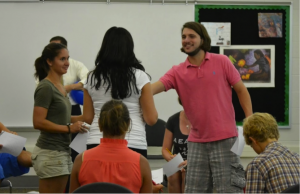By Brianna Rae

Today, our society is more sedentary than ever. As we’ve all heard, long periods of inactivity are linked to heart disease, obesity, and depression, as well as decreased physical stamina and mental aptitude (Mahar et al. 2006; Walker 2011). This is especially problematic in school settings, where students spend most of their time. Researchers who noticed this trend began studying elementary and high school students’ activity levels about 10 years ago (Ferrer & Laughlin 2017). Study after study showed that physical movement leads to improved learning, which led to the current efforts to incorporate physically active learning into classrooms. However, these initiatives are often limited to elementary and high school students, without considering that college-aged students would benefit from the same activities.
In college classrooms, students are expected to sit still for long periods of time. This long-honored tradition of stillness continues today, even though it actually inhibits the absorption of information (Lom, 2012). In fact, “long periods of instructional time without a break might be counterproductive to academic performance” (Mahar et al., 2006). I’m sure all of us can relate to a view of students fidgeting, or staring blankly into space, sometimes (or perhaps often) falling asleep. If we want out classrooms to be a good use of time, for both the students and ourselves, it would help to refresh energy levels a few times during a lecture or discussion section. One of the best ways to do this is with a so-called “brain break.”
Brain Breaks
Taking brief physical activity breaks during class elevates all of the characteristics that we want in our students: attentiveness, energy, and a well-functioning brain (Ferrer & Laughlin, 2017).
These so-called “brain breaks” have already begun to be used in a variety of classrooms (but again, usually only with younger students). “Brain breaks” are used because of their immediate physical effects: the heart rate rises, fresh oxygen is delivered to the brain, and neurotransmitters that promote longer attention spans are released (Walker 2011). Most instructors implement these breaks at regular intervals—say, every 20 or 30 minutes. Of course, the appropriate type and length of physical activities is ultimately up to each instructor, and will certainly vary based on the length of class time, number of students, and classroom shape and size.

One of the very few studies that have actually addressed the effects of these breaks on college students resulted in a 66% positive response to classroom brain break activities (Ferrer & Laughlin, 2017). While some students reported negative feedback, it was often because they did not understand the point of the activities. To avoid this, the researchers recommended explaining why the brain breaks are being used, as well as the benefits they provide. Students are also more willing to participate if given the opportunity to create their own brain break activities (Ferrer & Laughlin, 2017). Student feedback, either during the semester or at the end of the class, can be used to perceive the effectiveness (or not) of these activities on classroom attentiveness and learning, as well as overall class experience.
Sample Activities
Large lecture hall setting (tell students to secure notebooks, drinks, phone etc. before beginning)
- Have the class stand and sit back down 10 times
- Using only their right elbow, have students spell their first name in the air
- Have the class stand. Make a short clapping rhythm, and have students clap to mimic the rhythm. Repeat several times.
- Have students do simple standing stretches as space allows (clasped hands overhead, quadriceps stretch, try to touch toes, etc.)
Small classroom setting (small lectures, discussion sections)
- Have students line themselves up alphabetically by first letter of first name
- In warmer weather, take students on a quick walk outside and around the building
- Simply have students stand and shake out their arms and legs
- Ask students questions that have four possible answers, and have each answer correspond to a corner of the room. Have them move to the corner that matches their answer.
This video shows a TEDx talk with Michael Kuczala, who discusses the need for more physically active classrooms. He also offers a few demonstrations of activities that can be used in the classroom (at video minute times 4:40-6:15 and 11:05-12:43).
By incorporating physical activity into our college classrooms, we are recognizing students as holistic entities, whose comprehension and performance is directly tied to their body as a whole. We can use activities like brain breaks as a potential balm for the inevitable boredom and fatigue found in physically static classrooms. Introducing physical activities will also likely challenge everyone—teachers and students alike—to tread outside of their comfort zone. However, it is worth trying these techniques if we want to encourage more successful in-class learning, and potentially help students experience classrooms as a more energetic space. While classrooms do not have to have carnival-like atmosphere, small doses of physical activity have the potential to enliven students and ultimately make class time more enjoyable and productive for everyone. Ultimately, such activities give college instructors and TAs the opportunity to encourage students to have a healthy balance of physical and mental activity, both inside school and out.
References